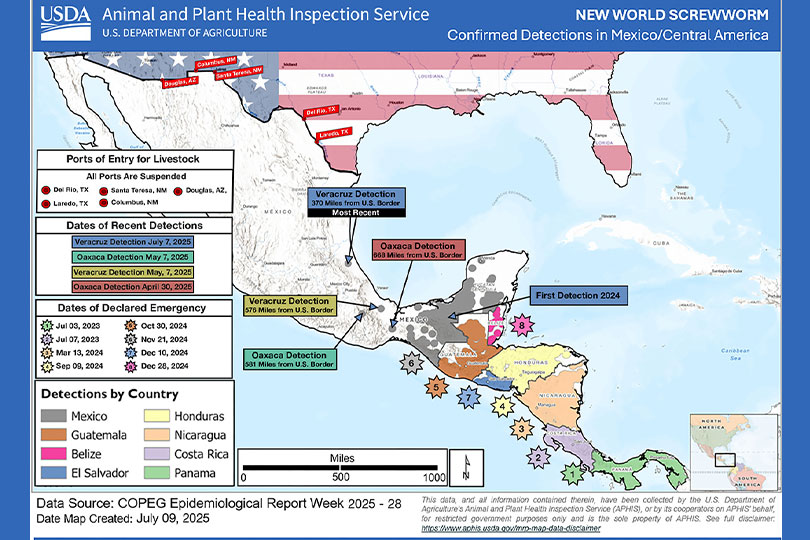By Julie Tomascik
Editor
Livestock trade across the U.S.-Mexico border is once again suspended, effective immediately.
U.S. Secretary of Agriculture Brooke Rollins made the announcement Wednesday evening, citing further northward spread of the New World screwworm (NWS).
The decision comes just two days after the U.S. Department of Agriculture (USDA) reopened the first port of entry for Mexican livestock in Douglas, Arizona. USDA had planned to gradually resume imports through four additional ports, including two in Texas, in the coming months.
That plan is now on hold following confirmation of a screwworm case in Ixhuatlán de Madero, Veracruz, which is about 370 miles from the U.S. border. It marks a continued northward spread of the parasite, with previous detections in Oaxaca and other areas of Veracruz in recent months.
“The United States has promised to be vigilant, and after detecting this new NWS case, we are pausing the planned port reopening’s to further quarantine and target this deadly pest in Mexico,” Rollins said in a statement. “Thanks to the aggressive monitoring by USDA staff in the U.S. and in Mexico, we have been able to take quick and decisive action to respond to the spread of this deadly pest,” Rollins said.
The New World screwworm, a flesh-eating parasite, poses a severe threat to livestock, wildlife, pets, and, in rare cases, humans. Its reintroduction into the U.S. would be devastating for the cattle industry and broader agricultural sector.
Cattle imports from Mexico play a major role in the U.S. beef supply. In 2024, the U.S. imported about $1.3 billion worth of Mexican cattle, the highest volume since 2020.
Both the U.S. and Mexico plan to increase screwworm eradication efforts.
Earlier this summer, USDA unveiled its five-pronged strategy to push back the pest, which includes a sterile fly dispersal facility at Moore Air Base in the Rio Grande Valley.
“This facility will provide a critical contingency capability to disperse sterile flies should a NWS detection be made in the southern United States,” USDA said in a statement.
The agency also announced it is moving forward with the design process to build a domestic sterile fly production facility to ensure it has the resources to push the screwworm back to the Dairen Gap.
“USDA is working on these efforts in lockstep with border states—Arizona, New Mexico and Texas—as it will take a coordinated approach with federal, state and local partners to keep this pest at bay and out of the U.S.,” according to an agency statement.
Texas Farm Bureau leaders say building a sterile fly dispersal facility in Texas is a much needed and strategic move in the fight against the screwworm.
“Locating the facility in Texas puts critical resources where they’re needed most—close to the threat,” Boening said. “It strengthens our defenses, allows for faster response times and protects the health of our livestock and wildlife industries, as well as the rural economy.”
USDA will also continue to have personnel conduct site visits throughout Mexico to ensure the Mexican government is following the enhanced protocols and surveillance measures.
For more information about the New World screwworm, visit screwwormtx.org.


Leave A Comment